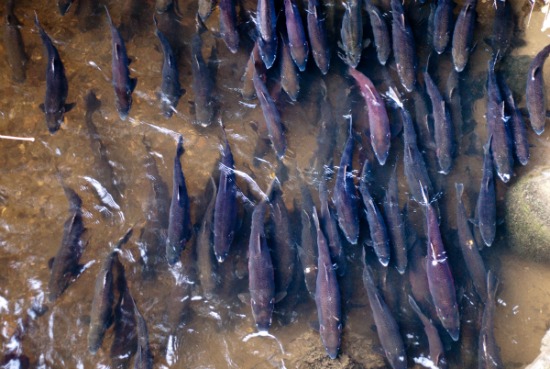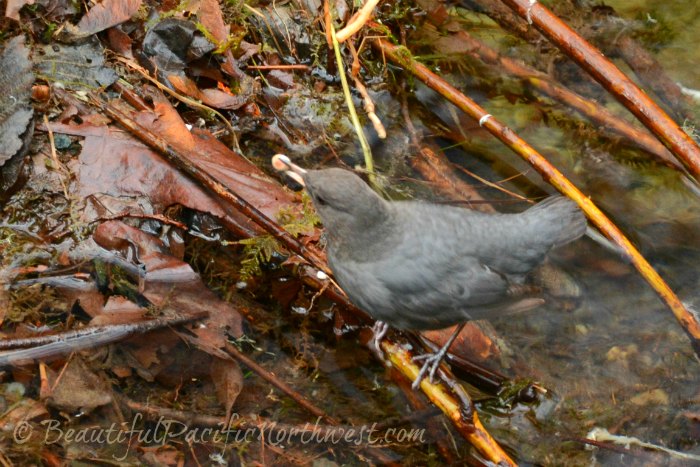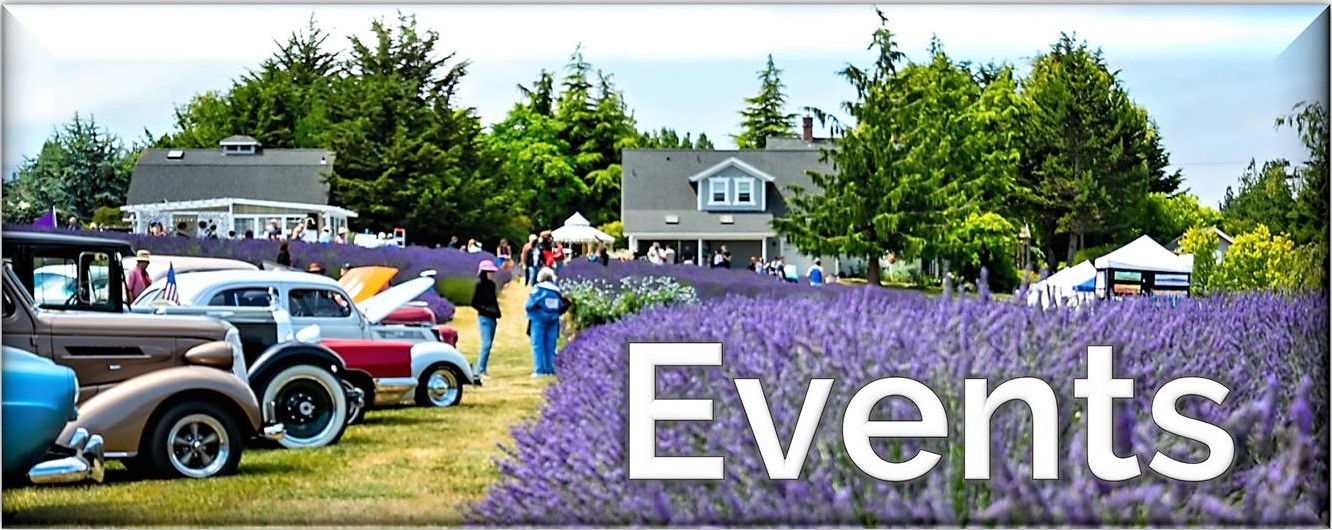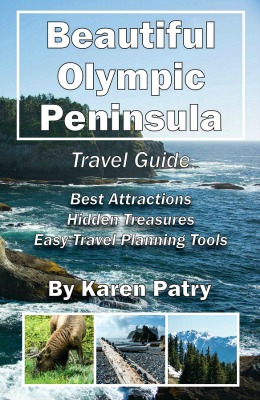Salmon Spawn
Salmon Spawn. Informative details about the how and why of spawning salmon. Plus see our video clip of coho salmon leaping in the Sol Duc River, within the Olympic National Park.
Imagine a fish species that begins life in fresh water, migrates to the salty ocean for years, and then overcomes all odds to return to the exact gravelly stream of its birth 7 years later to spawn and die.
The salmon spawn is one of those very nearly inexplicable events, yet this same amazing event occurs every year as though (unbelievably) a Creator might actually be caring for and nurturing Nature.
(Below: Pacific salmon enroute to their spawning beds. Image by Flickr user USFWS Pacific/Creative Commons)
- The fry are born in shallow freshwater streams.
- Within a few weeks to a few years after hatching, young salmon migrate down river to the ocean
- They spend a short season at the mouths of their natal rivers as their bodies make the physiological changes required for life in the salty ocean
- They live for 4-7 more years in the ocean before they once again return to the very stream in which they were born which may be thousands of miles away.
- Salmon are a keystone species - their dead bodies provide nutrients for both the flora and fauna in the riparian environments surrounding the salmon spawning streams as well as downstream in estuaries.
Opportunities to view spawning salmon abound throughout the Pacific Northwest
Were you to visit and view the spawning salmon in action, it might look something like the pictures on this page.
Additionally, here is a clip of salmon struggling to leap the Sol Duc Salmon Cascade during the 2012 Coho Salmon run.
How do salmon know how to get back to their birth stream?
While the exact mechanisms that guide the salmon are not clearly understood, it is believed that their guidance systems may be a combination of sensitivity to the earth’s magnetic field and their sense of smell, which is very strong.
Scientists think the earth’s magnetic signals (magnetoception) guide the salmon to the general position of the river where they were born. As they approach, they follow the scents pouring out of their natal stream, finding the entrance to the river and the exact tributary and stream in which they were born.
(Below: These salmon have arrived at their natal spawning grounds in Issaquah Creek, WA, and will soon pair up, dig redds and then die after completing their spawn. Image by Flickr user soggydan - Creative Commons)
Salmon don’t always end up in their exact birth stream 100% of the time, studies show. A few salmon may end up in a nearby stream, thereby helping to ensure sufficient genetic diversity of the species.
It also helps to ensure that creeks with disrupted environments will eventually become repopulated with new runs of salmon.
Salmon Are a Keystone Species
Salmon are known as a keystone species, because the entire ecosystem around the salmon spawning streams is dependent upon the nourishment that salmon provide. The ocean nutrients, nitrogen, sulfur, carbon and phosphorus, are transferred to the forest and its inhabitants upon the death of the salmon each year.
Salmon are North America's Answer to the Serengeti's Wildebeest
“Salmon continue to surprise us, showing us new ways in which their oceanic migrations eventually permeate entire terrestrialecosystems. In terms of providing food and nutrients to a whole food web, we like to think of them as North America's answer to the Serengeti's wildebeest” (Science Daily 2008).
(Below: A multitude of bright red spawning salmon are engrossed in their spawning activities in the same gravel stream bed where they hatched many years earlier. Image by Flickr user earth_and_env - Creative Commons)
Just 2% of the salmon eggs deposited survive the many years and hazards of life, managing to return to the stream where they were born in order to spawn and repeat the cycle.
Many are the ways that salmon fall prey:
- Cutthroat and steelhead trout lurk in the area long enough to make meals of salmon roe.
- Dippers (small birds) and gulls dine on roe.
- Many predators depend on salmon. Seals and sea lions, grizzlies, black bears, bald eagles and other bird species, mink, otters, raccoons, fox, and man are some of the main predators of salmon at various stages of life. Wolves prefer salmon over deer during the salmon spawn
Upon their death at the completion of the salmon spawn, the nutrients from the many dead salmon nourish every species within the environments surrounding the spawning beds. Birds and other animals drag salmon carcasses hundreds of feet into the forest. One study demonstrated that bears may leave up to half of their salmon harvest unconsumed on the forest floor. Their scat fertilizes the brush and trees.
Additionally, the nutrients drift downstream into estuaries for the nourishment of other species of breeding birds. The number of birds nesting in the spring is strongly correlated to the strength of the salmon run during the prior fall.
Should the salmon spawn terminate, the absence of salmon would create an environmental disaster for nearly the entire ecosystem.
View a Salmon Spawn Run for Yourself
The Salmon Cascades in the Sol Duc Valley of the Olympic National Park is a great place to watch the salmon fight their way upstream to their native spawning beds. I hope you enjoyed the above video!
When you get a chance to go view a salmon spawn run for yourself, here are some good tips for making the most of your experience:
- Salmon have great eyesight. If you’re simply viewing or photographing the salmon, you’ll get better views by wearing muted tones or camo colors.
- Cut the glare off the water by using polarized sunglasses. It will also keep your eyes from tiring quickly.
- Go higher young man (or woman). Finding higher viewing areas may improve your ability to witness the salmon spawn in action, especially if you also have binoculars or a telephoto camera lens.
- Allow the spawning salmon to go about their business, undisturbed by litter, dogs, or excessive commotion.
- If you’ve come to fish for salmon, look for salmon in the early stages of their salmon run – in the deeper wider waters of the river, in the mouth of the river, or still in the Pacific not far from the mouth of the river. At this point, salmon are at their peak condition and still silvery in appearance.
Even a rudimentary understanding of spawning salmon contributes to our appreciation of the awe of Nature and of the beauty and uniqueness of the Olympic Peninsula and the Pacific Northwest.
More on the various salmon species
Learn more about the salmon spawn: If you have opportunity, we recommend visiting an Olympic National Park Visitor Center (in Port Angeles or in the Hoh Rainforest) to take advantage of additional interactive educational programs or materials.
(Below: Spawning salmon. Image by Flickr user: soggydan - Creative Commons)
Have You Encountered Temperate Rainforest Wildlife?
Tell Your Story and Share Your Photos With Us!
Tell Your Story and Share Your Photos With Us!
Nature can present us with unexpected, breathtaking, and memorable moments! Do you have a great story or an interesting experience encountering any of the many Temperate Rainforest Wildlife species? We'd love to hear about it! Feel free to share it in the form below. Be as wordy and as descriptive as you like. Include photos as well, if you have them; there is plenty of room for it all on our website.
Just click into the title box below and go from there. When published, you'll have "your own" page on MyPortAngeles which you can share with friends or anyone who asks!
We're happy to ensure professional and amateur photographers get credit for their work. Leave us your name in the form below, and means of contact, website, or FB page info so we can link back to you.
References:
- https://www.mgfalaska.com/how-salmon-and-steelhead-spawn/
- https://en.wikipedia.org/wiki/Salmon_run
- http://www.goldstreampark.com/salmon.htm
- https://en.wikipedia.org/wiki/Salmon
- https://en.wikipedia.org/wiki/Trout










